-
 When “One Size Fits All” Fits None: A Commentary on the Impacts of the “Draft Canadian Breast Cancer Screening Guidelines” on Racialized Populations in Canada
When “One Size Fits All” Fits None: A Commentary on the Impacts of the “Draft Canadian Breast Cancer Screening Guidelines” on Racialized Populations in Canada -
 Perioperative Chemo-Immunotherapy in Non-Oncogene-Addicted Resectable Non-Small Cell Lung Cancer (NSCLC): Italian Expert Panel Meeting
Perioperative Chemo-Immunotherapy in Non-Oncogene-Addicted Resectable Non-Small Cell Lung Cancer (NSCLC): Italian Expert Panel Meeting -
 Feasibility and Acceptability of Social Prescribing for Cancer Survivors
Feasibility and Acceptability of Social Prescribing for Cancer Survivors
Journal Description
Current Oncology
Current Oncology
is an international, peer-reviewed, open access journal published online by MDPI (from Volume 28 Issue 1-2021). Established in 1994, the journal represents a multidisciplinary medium for clinical oncologists to report and review progress in the management of this disease. The Canadian Association of Medical Oncologists (CAMO), the Canadian Association of Psychosocial Oncology (CAPO), the Canadian Association of General Practitioners in Oncology (CAGPO), the Cell Therapy Transplant Canada (CTTC), the Canadian Leukemia Study Group (CLSG) and others are affiliated with the journal and their members receive a discount on the article processing charges.
- Open Access— free for readers, with article processing charges (APC) paid by authors or their institutions.
- High Visibility: indexed within Scopus, SCIE (Web of Science), PubMed, MEDLINE, PMC, Embase, and other databases.
- Journal Rank: JCR - Q2 (Oncology)
- Rapid Publication: manuscripts are peer-reviewed and a first decision is provided to authors approximately 19.8 days after submission; acceptance to publication is undertaken in 2.4 days (median values for papers published in this journal in the second half of 2024).
- Recognition of Reviewers: APC discount vouchers, optional signed peer review, and reviewer names published annually in the journal.
Impact Factor:
2.8 (2023);
5-Year Impact Factor:
2.9 (2023)
Latest Articles
Oncology Nurses’ Attitudes, Knowledge, and Practices in Providing Sexuality Care to Cancer Patients: A Scoping Review
Curr. Oncol. 2025, 32(6), 337; https://doi.org/10.3390/curroncol32060337 (registering DOI) - 7 Jun 2025
Abstract
►
Show Figures
Sexual health in cancer care is often overlooked. This study examines oncology nurses’ knowledge and practices regarding sexuality care, identifying barriers and facilitators. A Preferred Reporting Items for Systematic reviews and Meta-Analyses (PRISMA)-guided search of Scopus, ScienceDirect, PubMed, and EBSCO focused on studies
[...] Read more.
Sexual health in cancer care is often overlooked. This study examines oncology nurses’ knowledge and practices regarding sexuality care, identifying barriers and facilitators. A Preferred Reporting Items for Systematic reviews and Meta-Analyses (PRISMA)-guided search of Scopus, ScienceDirect, PubMed, and EBSCO focused on studies from 2014 to 2024. Of 1735 identified studies, only 11 met inclusion criteria. Findings revealed a lack of knowledge among nurses and dissatisfaction with sexual healthcare. Barriers include time constraints, cultural factors, and personal reservations. Routine discussions are often absent due to inadequate training. Education- and system-based strategies are needed to enhance nurses’ competence in addressing sexual concerns. Implementing training programs, structured records, evaluation tools, concept maps, and system support would improve patient care and oncology nursing practices. Addressing these gaps with practical measures can enhance communication, patient satisfaction, and quality of life. This unique analysis was conducted by two experienced advanced nurses in the Middle East, where discussions about sex are often regarded as taboo.
Full article
Open AccessArticle
Evaluating the Cost-Effectiveness of Cervical Cancer Screening and Treatment in Western Romania
by
Ion Petre, Șerban Mircea Negru, Florina Buleu, Radu Dumitru Moleriu, Marina Adriana Mercioni, Izabella Petre, Anca Bordianu, Vladiana Turi, Luciana Marc, Daian Ionel Popa and Daliborca Cristina Vlad
Curr. Oncol. 2025, 32(6), 336; https://doi.org/10.3390/curroncol32060336 (registering DOI) - 7 Jun 2025
Abstract
Background and Objectives: As a leading European country in terms of cervical cancer incidence and mortality, there has been a pressing need for Romania to upgrade its cervical cancer management. The criteria set by the International Federation of Gynecology and Obstetrics indicate that
[...] Read more.
Background and Objectives: As a leading European country in terms of cervical cancer incidence and mortality, there has been a pressing need for Romania to upgrade its cervical cancer management. The criteria set by the International Federation of Gynecology and Obstetrics indicate that different treatments should have a similar trend concerning progression-free survival and overall survival at all the various stages of cervical cancer. This study aimed to assess the cost-effectiveness (CE) of the primary treatment plans related to the survival rate for cervical cancer screening in the western part of Romania and provide some recommendations. Materials and Methods: Descriptive statistics and a correlation model were used to examine costs. AI models have been developed to forecast the CE of different treatments using the above-mentioned studies on overall survival rates and treatment-related toxicity rates for five years. The costs of cervical cancer treatment were sourced from the public health department, the oncology clinic in the western region of Romania, and the County Hospital available for each stage. Results: Treatment expenses vary by cancer stage, with a significant increase from stages IA/IB to IIA, stabilizing between IIA and IIIC (about €7800–€8300), followed by a steep decline in IVA and a more pronounced decrease in IVB and in situ. The results highlight certain treatment combinations and their costs, indicating that the highest costs (exceeding €8000) are linked to multimodal treatments, which encompass surgery, chemotherapy, radiotherapy, and brachytherapy. Conclusions: Advanced cancer stages (IIA–IIIC) entail the highest treatment costs due to intricate, multimodal therapy, whereas early stages (IA, IB, in situ) and late terminal stages (IVB) are linked to considerably reduced treatment costs.
Full article
(This article belongs to the Section Health Economics)
►▼
Show Figures

Figure 1
Open AccessArticle
Increased Pre-Operative Lung Immune Prognostic Index Score Is a Prognostic Factor in Cases of Pathological T3 Renal Cell Carcinoma
by
Hayato Hoshina, Toru Sugihara, Masayuki Kurokawa, Ei-ichiro Takaoka, Satoshi Ando, Haruki Kume and Tetsuya Fujimura
Curr. Oncol. 2025, 32(6), 335; https://doi.org/10.3390/curroncol32060335 (registering DOI) - 7 Jun 2025
Abstract
We assessed the efficacy of the lung immune prognostic index (LIPI) in predicting the progression of pathological T3 renal cell carcinoma (RCC). The LIPI scores of patients with pathological T3 RCC were calculated in the pre- and post-operative phases. Patients were divided into
[...] Read more.
We assessed the efficacy of the lung immune prognostic index (LIPI) in predicting the progression of pathological T3 renal cell carcinoma (RCC). The LIPI scores of patients with pathological T3 RCC were calculated in the pre- and post-operative phases. Patients were divided into zero-point, one-point, and two-point groups according to their LIPI score and into the upstage and non-upstage groups according to the pre- and post-operative increase in LIPI score. Overall survival (OS) was evaluated using Kaplan–Meier curves stratified by group. Univariate and multivariate analyses of OS were performed via Cox proportional hazard regression analysis. LIPI scores were calculated in 80 patients wherein blood sampling data were available. The upstage and non-upstage groups comprised eight and seventy-two patients, respectively. Kaplan–Meier curves showed a significant difference in the pre- to post-operative LIPI score upstage group. LIPI score change was a poor prognostic factor using univariate analysis (OS: hazard ratio (HR) = 4.10, 95% confidence interval (CI) = 1.07–15.61, p = 0.038) and multivariate analysis (OS: HR = 4.38, 95% CI = 1.13–16.89, p = 0.031). An increase in the LIPI score in the pre-operative phase was a poor prognostic factor for pathological T3 RCC.
Full article
(This article belongs to the Section Surgical Oncology)
►▼
Show Figures
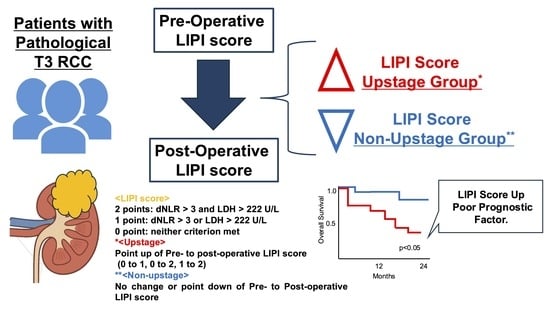
Graphical abstract
Open AccessArticle
Using Machine Learning Approaches on Dynamic Patient-Reported Outcomes to Cluster Cancer Treatment-Related Symptoms
by
Nora Asper, Hans Friedrich Witschel, Louise von Stockar, Emanuele Laurenzi, Hans Christian Kolberg, Marcus Vetter, Sven Roth, Gerd Kullak-Ublick and Andreas Trojan
Curr. Oncol. 2025, 32(6), 334; https://doi.org/10.3390/curroncol32060334 - 6 Jun 2025
Abstract
►▼
Show Figures
In patients undergoing systemic treatment for cancer, symptom tracking via electronic patient-reported outcomes (ePROs) has been used to optimize communication and monitoring, and facilitate the early detection of adverse effects and to compare the side effects of similar drugs. We aimed to examine
[...] Read more.
In patients undergoing systemic treatment for cancer, symptom tracking via electronic patient-reported outcomes (ePROs) has been used to optimize communication and monitoring, and facilitate the early detection of adverse effects and to compare the side effects of similar drugs. We aimed to examine whether the patterns in electronic patient-reported outcomes, without any additional clinician data input, are predictive of the underlying cancer type and reflect tumor- and treatment-associated symptom clusters (SCs). The data were derived from a total of 226 patients who self-reported on the presence and severity (according to the Common Terminology Criteria for Adverse Events (CTCAEs)) of more than 90 available symptoms via the mediduxTM app (versions 2.0 and 3.2, developed by mobile Health AG based in Zurich, Switzerland). Among these, 172 had breast cancer as the primary tumor, 19 had lung, 16 had gut, 12 had blood–lymph, and 7 had prostate cancer. For this secondary analysis, a subgroup of 25 patients with breast cancer were randomly selected to reduce the risk of overfitting. The symptoms were aggregated by counting the days on which a particular symptom was reported, resulting in a symptom vector for each patient. A logistic regression model was trained to predict the type of the respective tumor from the symptom vectors, and the symptoms with coefficients above (0.1) were graphically displayed. The machine learning model was not able to recognize any of the patients with prostate and blood–lymph cancer, likely as these cancer types were barely represented in the dataset. The Area Under the Curve (AUC) values for the three remaining cancer types were breast cancer: 0.74 (95% CI [0.624, 0.848]); gut cancer: 0.78 (95% CI [0.659, 0.893]); and lung cancer: 0.63 (95% CI [0.495, 0.771]). Despite the small datasets, for the breast and gut cancers, the respective models demonstrated a fair predictive performance (AUC > 0.7). The generalization of the findings are limited especially due to the heterogeneity of the dataset. This line of research could be especially interesting to monitor individual treatment trajectories. Deviations in the electronic patient-reported symptoms from the treatment-associated symptom patterns could dynamically indicate treatment non-adherence or lower treatment efficacy, without clinician input or additional costs. Similar analyses on larger patient cohorts are needed to validate these preliminary findings and to identify specific and robust treatment profiles.
Full article

Graphical abstract
Open AccessArticle
Germline TP53 p.R337H and XAF1 p.E134* Variants: Prevalence in Paraguay and Comparison with Rates in Brazilian State of Paraná and Previous Findings at the Paraguayan–Brazilian Border
by
Edith Falcon-de Legal, Marta Ascurra, Rosa Vega-Paredes, Elis Sade, Magna Monteiro, Mariana Paraízo, Magali Colman, Angeles Gutierrez Florentin, Cesar Ojeda, Horacio Legal-Ayala and Andreas Ries
Curr. Oncol. 2025, 32(6), 333; https://doi.org/10.3390/curroncol32060333 - 6 Jun 2025
Abstract
Adrenal cortex carcinoma (ACC) in children is a rare tumor that is probably of multifactorial origin and is mainly associated with genetic and environmental alterations. In the south and part of the southeast of Brazil, as well as in the Paraguayan region bordering
[...] Read more.
Adrenal cortex carcinoma (ACC) in children is a rare tumor that is probably of multifactorial origin and is mainly associated with genetic and environmental alterations. In the south and part of the southeast of Brazil, as well as in the Paraguayan region bordering the Brazilian State of Paraná, ACC prevalence is higher than in any other country, which is associated with the high prevalence of the TP53 p.R337H variant in Paraná (0.30%), Santa Catarina (0.249%), cities around Campinas-SP (0.21%), and the Paraguayan cities on the border with Paraná (0.05%). Recent research suggests that the co-segregation of XAF1-E134* and TP53-R337H mutations leads to a more aggressive cancer phenotype than TP53-R337H alone. Breast cancer may be mildly influenced by co-segregation with XAF1 p.E134*, and this variant can also confer risk for sarcoma. Objectives: The objectives of this study were to (1) estimate the prevalence of the germline TP53 p.R337H and XAF1 p.E134* variants in Paraguay (excluding cities on the border with Paraná State, Brazil) and (2) estimate whether the ethnic origin of TP53 p.R337H carriers in Paraguay is similar to that of ethnic groups in Paraná (possible Portuguese/Spanish origin). Materials and methods: DNA tests for the identification of TP53 p.R337H were carried out from 2016 to 2019 at the Bio-Materials Laboratory of Facultad Politecnica, UNA, and at the Research Center in Biotechnology and Informatics (CEBIOTEC), Asunción, Paraguay. Polymerase chain reaction followed by restriction enzyme digestion (PCR-RFLP) was used to identify TP53 p.R337H, and real-time PCR (RT-PCR) was employed for XAF1 p.E134*. Peripheral blood samples from 40,000 Paraguayan newborns (NBs) were used for the TP53 p.R337H tests. The XAF1 p.E134* tests (RT-PCR) were performed on samples from 2000 Paraguayan newborns at the Pelé Pequeno Principe Research Institute, Curitiba, PR, Brazil. Results: The TP53 p.R337H variant was not found in any of the 14 Paraguayan departments investigated. A total of 12 of the 2000 Paraguayan NBs were positive for one XAF1 p.E134* allele. Conclusions: The hypothesis of Spanish immigrants carrying p.R337H to Paraguay was disproved. TP53 p.R337H neonatal testing in Paraguay is not recommended, except when there are families with Brazilian ancestry presenting cancer cases. Additional epidemiological studies are required to determine the likelihood of the identified prevalence of the XAF1 p.E134* allele (1/153) in NBs from Paraguay without TP53 p.R337H to present cancer risk. This study complements the first national initiative for the DNA screening of newborns aimed at mapping the TP53 p.R337H and XAF1 p.E134* variants in Paraguay (based on the regions of residence of the newborns).
Full article
(This article belongs to the Special Issue Updates on Diagnosis and Treatment for Pediatric Solid Tumors)
►▼
Show Figures

Figure 1
Open AccessArticle
Quality of Life of Lung Cancer Patients with Immune-Related Endocrinopathies During Immunotherapy: A Prospective Study Based on the EORTC QLQ-C30 and QLQ-LC13 Questionnaires in Romania
by
Simona Coniac, Mariana Cristina Costache-Outas, Ionuţ-Lucian Antone-Iordache, Alexandra-Valentina Anghel, Maria-Alexandra Bobolocu, Andreea Zamfir, Horia-Dan Liscu, Andreea-Iuliana Ionescu and Corin Badiu
Curr. Oncol. 2025, 32(6), 332; https://doi.org/10.3390/curroncol32060332 - 5 Jun 2025
Abstract
(1) Background: Globally, lung cancer is the leading cause of cancer death, but immunotherapy has impressively improved the outcomes, generating longer progression-free survival and overall survival. Endocrine immune-related adverse events (irAEs) are mostly irreversible and need life-long hormonal substitution therapy. The evaluation of
[...] Read more.
(1) Background: Globally, lung cancer is the leading cause of cancer death, but immunotherapy has impressively improved the outcomes, generating longer progression-free survival and overall survival. Endocrine immune-related adverse events (irAEs) are mostly irreversible and need life-long hormonal substitution therapy. The evaluation of the quality of life of lung cancer patients experiencing endocrine toxicities during immune checkpoint inhibitor (ICI) treatment is relevant for both patients and healthcare providers. (2) Methods: This was a prospective cohort study of lung cancer patients treated with immune checkpoint inhibitors in a tertiary-level hospital in Romania from 1 December 2021 to 30 September 2024. Quality of life was assessed using versions of the EORTC QLQ-C30 and EORTC QLQ-LC-13 validated and translated into the Romanian language. We investigated several clinical variables to evaluate their impact on QoL. (3) Results: Fifty-nine lung cancer patients were evaluated for their QoL before ICI initiation and at the end of the study. Endocrine-irAEs occurred in 17 lung cancer patients (28.8%). Quality of life as assessed using the EORTC questionnaires was statistically significantly improved, even in patients experiencing endocrine-irAEs. (4) Conclusions: Our prospective cohort study succeeded in delivering the proof of concept of an increased QoL in lung cancer patients who had developed endocrine-irAEs under immunotherapy. Despite toxicities, especially rather frequent endocrine-irAEs, ICIs enabled durable disease control and symptom relief, improving the QoL of the overall trial population. As more lung cancer patients undergo immunotherapy in metastatic or early stages, we draw attention to this particular patient population with autoimmune endocrinopathies, as they will live longer and require life-long hormonal therapy.
Full article
(This article belongs to the Special Issue Palliative Care and Supportive Medicine in Cancer)
Open AccessArticle
PTEN Mutations Associated with Increased Recurrence and Decreased Survival in Patients with Prostate Cancer Spinal Metastasis
by
Albert Antar, Yuanxuan Xia, Abdel-Hameed Al-Mistarehi, Pritika Papali, Melanie Alfonzo Horowitz, Shreya Sriram, Shahab Aldin Sattari, Carly Weber-Levine, Sushanth Neerumalla, Benjamin Z. Mendelson, Sang Lee, Kristin J. Redmond, Ali Bydon, Timothy F. Witham, Nicholas Theodore and Daniel Lubelski
Curr. Oncol. 2025, 32(6), 331; https://doi.org/10.3390/curroncol32060331 - 4 Jun 2025
Abstract
Introduction: Prostate cancer with spinal metastases (PCSM) is associated with high morbidity and mortality. The impact of biomarkers on the prognosis of spinal metastases, however, remains unclear. Objective: This study explored associations between potential biomarkers, treatment modalities, survival, and neurological outcomes in PCSM
[...] Read more.
Introduction: Prostate cancer with spinal metastases (PCSM) is associated with high morbidity and mortality. The impact of biomarkers on the prognosis of spinal metastases, however, remains unclear. Objective: This study explored associations between potential biomarkers, treatment modalities, survival, and neurological outcomes in PCSM patients. Methods: We conducted a retrospective analysis of 68 patients as part of a neurosurgical cohort with PCSM at a comprehensive cancer center from 2013 to 2023, examining the influence of potential biomarkers, treatment modalities, and demographics on prognosis. The primary outcomes were the identification of biomarkers, overall survival (OS) in years, survival after spinal metastasis in years, spinal metastasis recurrence, and postoperative neurological outcomes via Frankel scores. Results: All the patients (n = 68) had adenocarcinoma, and the median age was 69 years. The mortality rate was 66% with a median OS of 6 years. Seventy-two biomarkers were identified. An accelerated failure time model (AFT) showed that radiotherapy to the prostate increased the OS (TR = 1.805, p = 0.001), while smoking status (TR = 0.625, p < 0.001) and PTEN gene mutations (TR = 0.504, p = 0.006) were associated with decreased OS. Kaplan–Meier analysis associated PTEN mutations with reduced median OS using the Gehan–Breslow–Wilcoxon test (3.50 vs. 9.49 years; p = 0.001). PTEN mutations were trending towards but were not significant for decreased survival following spinal metastases (2.04 vs. 3.15 years; p = 0.08). Both PTEN (p = 0.02) and Tumor Protein 53 (TP53, p = 0.01) mutations were associated with increased spinal metastasis recurrence when analyzed using Fisher’s exact test. No differences were observed in the median OS or survival after spinal metastases among patients with or without androgen receptor splice variant-7 (AR-V7), prostate-specific membrane antigen (PSMA), TP53, or other analyzed biomarkers. Similarly, neither age, receipt of chemotherapy, nor radiotherapy to the spine correlated with OS. Only chemotherapy was associated with a decreased postoperative Frankel Score (p = 0.002). Conclusions: PTEN mutations and smoking status were associated with decreased OS in patients with PCSM. Both PTEN and TP53 mutations were associated with increased spinal metastasis recurrence. Receipt of radiotherapy to the prostate was correlated with prolonged survival, whereas receipt of radiotherapy to the spine was not. Chemotherapy was associated with decreased postoperative neurological outcomes.
Full article
(This article belongs to the Section Genitourinary Oncology)
►▼
Show Figures

Figure 1
Open AccessCase Report
Perivascular Epithelioid Cell Tumor (PEComa) of the Sigmoid Colon: Case Report and Literature Review
by
Gintare Slice, Rokas Stulpinas, Tomas Poskus and Marius Kryzauskas
Curr. Oncol. 2025, 32(6), 330; https://doi.org/10.3390/curroncol32060330 - 3 Jun 2025
Abstract
Perivascular epithelioid cell tumors (PEComas) are rare mesenchymal neoplasms characterized by perivascular epithelioid cell proliferation. They can occur in various organs, but colonic PEComas are exceptionally rare, showing diagnostic challenges due to their nonspecific clinical presentation and similar features to those of other
[...] Read more.
Perivascular epithelioid cell tumors (PEComas) are rare mesenchymal neoplasms characterized by perivascular epithelioid cell proliferation. They can occur in various organs, but colonic PEComas are exceptionally rare, showing diagnostic challenges due to their nonspecific clinical presentation and similar features to those of other colorectal tumors. We present a case of a 61-year-old female with defecation accompanied by blood clots, initially diagnosed with a suspected tumor in the sigmoid colon. Despite initial biopsy yielding non-informative material, repeat colonoscopy and imaging studies revealed a malignant tumor with multinucleated giant (osteoclast-like) cells and probable p53 mutation, most likely of mesenchymal origin. Robotic surgical resection was performed, and ultimately pathological examination refined the diagnosis as a malignant PEComa of the colon. This case demonstrates the importance of considering PEComa in the differential diagnosis of colonic tumors. Further research is needed to ascertain the clinical behavior and optimal treatment for colonic PEComas.
Full article
(This article belongs to the Section Gastrointestinal Oncology)
►▼
Show Figures
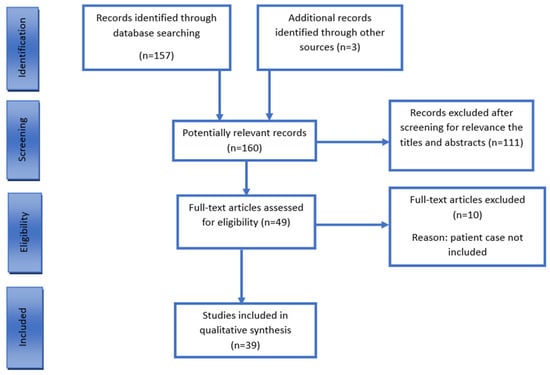
Figure 1
Open AccessReview
Mechanisms and Functions of γδ T Cells in Tumor Cell Recognition
by
Jing Tang, Chen Wu, Jintong Na, Yamin Deng, Simin Qin, Liping Zhong and Yongxiang Zhao
Curr. Oncol. 2025, 32(6), 329; https://doi.org/10.3390/curroncol32060329 - 3 Jun 2025
Abstract
γδ T cells are among the first line of defense in the immune system, playing a crucial role in bridging innate and adaptive immunity. Although γδ T cells are crucial for tumor immune surveillance, the complete mechanism by which γδ T cell receptors
[...] Read more.
γδ T cells are among the first line of defense in the immune system, playing a crucial role in bridging innate and adaptive immunity. Although γδ T cells are crucial for tumor immune surveillance, the complete mechanism by which γδ T cell receptors identify molecular targets in target cells remains unknown. Target cells can produce phosphoantigens (PAgs) via the mevalonate pathway or the methylerythritol phosphate pathway. The BTN3A1–BTN2A1 complex undergoes conformational changes in its extracellular domains upon binding to PAgs, leading to Vγ9Vδ2 T cell recognition. However, the structural basis of how Vγ9Vδ2 T cells recognize changes in this complex remains elusive. This review provides a detailed overview of the historical progress and recent discoveries regarding how Vγ9Vδ2 T cells recognize and target tumor cells. We also discuss the potential of γδ T cells immunotherapy and their role as antitumor agents.
Full article
(This article belongs to the Section Cell Therapy)
►▼
Show Figures

Graphical abstract
Open AccessArticle
Prognostic Factors and Treatment Outcomes in Gallbladder Cancer Patients Undergoing Curative Surgery: A Multicenter Retrospective Cohort Study
by
Bowen Xu, Yanjiang Yin, Jianping Chang, Zhiyu Li, Xinyu Bi, Jianqiang Cai and Xiao Chen
Curr. Oncol. 2025, 32(6), 328; https://doi.org/10.3390/curroncol32060328 - 3 Jun 2025
Abstract
Background: Gallbladder cancer (GBC) is a highly aggressive malignancy often diagnosed at an advanced stage due to its asymptomatic onset. Despite surgery being the only potentially curative option, recurrence and poor prognosis remain common, especially in advanced-stage diseases. There is limited consensus regarding
[...] Read more.
Background: Gallbladder cancer (GBC) is a highly aggressive malignancy often diagnosed at an advanced stage due to its asymptomatic onset. Despite surgery being the only potentially curative option, recurrence and poor prognosis remain common, especially in advanced-stage diseases. There is limited consensus regarding the extent of lymphadenectomy, hepatic resection, and the role of adjuvant therapies. Identifying prognostic factors and optimizing treatment strategies are critical for improving outcomes. This multicenter retrospective study was conducted to evaluate the clinical and pathological predictors of survival and recurrence in GBC patients that underwent radical surgery and to assess the potential benefit of adjuvant therapies in advanced stages. Methods: This was a retrospective cohort study of GBC patients who underwent curative-intent resection for GBC between 2010 and 2022 at two tertiary medical centers in China. The baseline characteristics, surgical data, pathology, adjuvant therapy, and follow-up outcomes were analyzed. The survival outcomes were assessed using Kaplan–Meier methods and Cox regression models. Subgroup analyses were conducted to explore the impact of postoperative adjuvant chemotherapy, period of surgical treatment, and extent of resection. Multiple imputation was used to address missing data. Results: The 5-year overall survival (OS) rate was 57.4%. Independent predictors of a poorer OS included CA19-9 > 30 U/mL (HR = 1.861, p = 0.003), poor/moderate-to-poor differentiation (HR = 2.134, p = 0.004), T3–T4 stage (HR = 2.685, p = 0.001), N1–N2 stage (HR = 2.217, p = 0.002), M1 stage (HR = 2.308, p = 0.001), and a high CAN score (HR = 1.875, p = 0.009). Adjuvant chemotherapy improved the OS in the stage III–IV patients (24.8 vs. 17.3 months, p = 0.036), though the DFS improvement was not significant (p = 0.133). No survival difference was observed between the segment IVb + V resection and wedge resection in the T2b patients. The patients treated after 2017 had a better OS (p = 0.024), possibly due to improved surgical techniques and perioperative care. Conclusions: Radical surgery remains critical for GBC. Accurate staging and tailored perioperative strategies, including chemotherapy, may improve outcomes, though further prospective studies are needed to validate these findings.
Full article
(This article belongs to the Special Issue Biliary Tract Cancer Updates: Advancements and Insights)
►▼
Show Figures

Figure 1
Open AccessFeature PaperArticle
Voices from the Margins: Barriers and Facilitators to HPV Self-Sampling Among Structurally Marginalized People with a Cervix in the Greater Toronto Area and Ontario
by
Mandana Vahabi, Natasha Kithulegoda, Masoomeh Moosapoor, Aisha Lofters, Josephine Pui-Hing Wong, Abdolreza Akbarian and Jenna Hynes
Curr. Oncol. 2025, 32(6), 327; https://doi.org/10.3390/curroncol32060327 - 3 Jun 2025
Abstract
Sex workers and formerly incarcerated people with a cervix face significant structural, interpersonal, and emotional barriers to cervical cancer screening, despite being at elevated risk for HPV infection. HPV self-sampling (HPV-SS) is a validated, user-directed method that has the potential to address these
[...] Read more.
Sex workers and formerly incarcerated people with a cervix face significant structural, interpersonal, and emotional barriers to cervical cancer screening, despite being at elevated risk for HPV infection. HPV self-sampling (HPV-SS) is a validated, user-directed method that has the potential to address these barriers, yet it remains excluded from Ontario’s organized screening program. This qualitative study explored the lived experiences of structurally marginalized individuals with a cervix who were offered HPV-SS as part of a mixed-methods pilot in the Greater Toronto Area. Five virtual focus groups were conducted with 34 participants, including both those who used the HPV-SS kit and those who declined it. Using inductive thematic analysis, we identified barriers to traditional screening including fear, stigma, mistrust of healthcare providers, logistical constraints, and a lack of accessible information. HPV-SS was widely described as more acceptable, empowering, and emotionally manageable, offering participants autonomy, privacy, and control over their care. Concerns included swab design, uncertainty about correct use, and unclear follow-up after positive results. Participants offered concrete, community-informed recommendations to improve HPV-SS implementation, including opt-in distribution models, gender-affirming language, and trauma-informed educational materials. The findings highlight the urgent need to integrate HPV-SS into organized screening programs to advance equitable access to cervical cancer prevention for marginalized populations.
Full article
(This article belongs to the Special Issue Action and Impact: Prevention and Screening Strategies Contributing to the Elimination of Cervical Cancer)
►▼
Show Figures

Figure 1
Open AccessArticle
Self-Management Support for Cancer Survivors: A Descriptive Evaluation of the Symptom Navi Training from the Perspective of Health Care Professionals
by
Marika Bana, Selma Riedo and Karin Ribi
Curr. Oncol. 2025, 32(6), 326; https://doi.org/10.3390/curroncol32060326 - 2 Jun 2025
Abstract
The Symptom Navi Program (SNP) is a self-management support (SMS) intervention for people with cancer. It consists of self-management supportive leaflets, educational conversations, and two standardized training sessions. A descriptive quality evaluation method was used to evaluate SNP implementation across 14 cancer services
[...] Read more.
The Symptom Navi Program (SNP) is a self-management support (SMS) intervention for people with cancer. It consists of self-management supportive leaflets, educational conversations, and two standardized training sessions. A descriptive quality evaluation method was used to evaluate SNP implementation across 14 cancer services from 2021 to 2024. We evaluated training content, methods, and participants’ confidence to use SMS in their clinical routine. Nurses, social workers, and psychologists completed ad hoc closed and open-ended questions after each training. The Work Sense of Coherence (Work-SoC) scale was used to elicit participants’ self-reported perceptions of their work context at cancer services. A series of descriptive analyses were conducted on the Work-SoC scale, the training content, and the methods. In addition, training-specific questions and predefined hypotheses were correlated. Thematic analysis was employed to examine open-ended questions. The SNP training content and methods largely met participants’ needs. Participants’ confidence in applying educational conversations decreased over time. The findings suggest a robust correlation between the application of educational conversations in daily routines and the participants’ perceptions regarding the comprehensibility and manageability of their work situations. Future research focusing on the implementation of SMS in clinical practice should examine the work context.
Full article
(This article belongs to the Special Issue Self-Management/Patient Activation and Self-Management Support Interventions for Cancer Survivors)
►▼
Show Figures
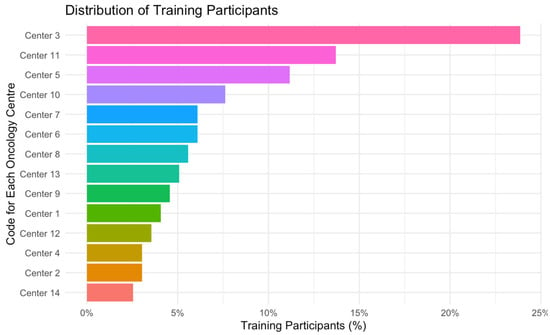
Figure 1
Open AccessSystematic Review
Incidence and Risk Factors of Platinum-Based Chemotherapy-Induced Nausea and Vomiting: A Systematic Review and Meta-Analysis
by
Kaili Jin, Xianlei Lin, Xiaoting Xia, Huiling Ye, Dan Yang, Ying Fan, Qiuhua Sun and Rongyun Wang
Curr. Oncol. 2025, 32(6), 325; https://doi.org/10.3390/curroncol32060325 - 31 May 2025
Abstract
Background: Platinum-based chemotherapy significantly increases the risk of nausea and vomiting, which can impair the treatment’s efficacy and the patient’s quality of life. This meta-analysis examines the incidence and risk factors of platinum-based chemotherapy-induced nausea and vomiting (PINV) in patients treated with this
[...] Read more.
Background: Platinum-based chemotherapy significantly increases the risk of nausea and vomiting, which can impair the treatment’s efficacy and the patient’s quality of life. This meta-analysis examines the incidence and risk factors of platinum-based chemotherapy-induced nausea and vomiting (PINV) in patients treated with this chemotherapy. Methods: This systematic review and meta-analysis were conducted in accordance with the PRISMA 2020 guidelines. We conducted a literature search in the databases PubMed, Embase, Web of Science, WanFang, China Science and Technology Journal Database (VIP), China National Knowledge Infrastructure (CNKI), and Chinese Medical Association Journal Database (CMAJD) through to 20 January 2025. Studies that reported the incidence and identified risk factors of nausea and vomiting specifically in patients receiving platinum-based chemotherapy were included in the review. The data were extracted independently by two reviewers. The odds ratios (ORs) for each risk factor were calculated from the included studies. Sensitivity analyses and additional subgroup analyses were performed to ensure the robustness of our findings. Results: This meta-analysis included 32 studies involving 14,207 participants. Female sex (OR = 2.363, 95% CI = 1.363–4.096, p = 0.002), anxiety (OR = 1.689, 95% CI = 1.057–2.700, p = 0.028), fatigue (OR = 1.413, 95% CI = 1.145–1.744, p = 0.001), motion sickness (OR = 1.816, 95% CI = 1.266–2.605, p = 0.001), and a history of vomiting during chemotherapy (OR = 2.728, 95% CI = 1.468–5.069, p = 0.002) were significantly associated with an increased risk of PINV. Conclusion: Female sex, anxiety, fatigue, motion sickness, and a history of vomiting during chemotherapy increase the risk of PINV during platinum-based treatments.
Full article
(This article belongs to the Section Palliative and Supportive Care)
►▼
Show Figures
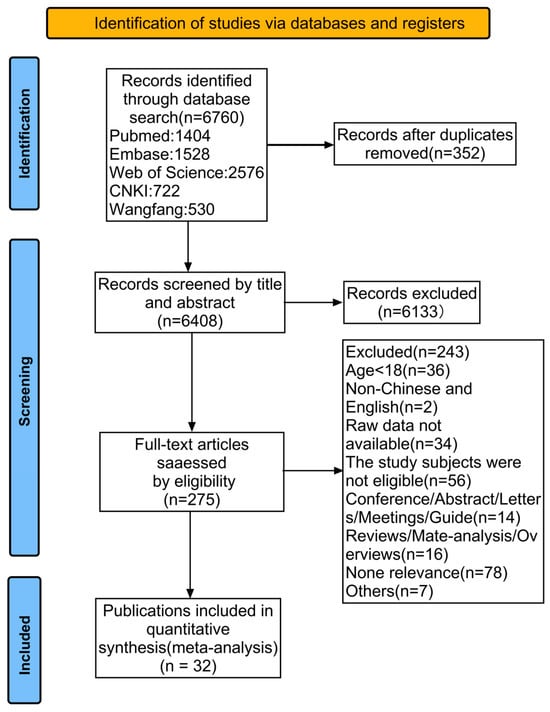
Figure 1
Open AccessArticle
Global Incidence Trend of Early-Onset Obesity-Related and Non-Obesity-Related Cancers
by
Miyu Terashima, Kota Nakayama, Satoko Ugai, Hwa-Young Lee, Yuta Tsukumo, Etsuji Suzuki, Hiroki Mizuno, Minkyo Song, Naoko Sasamoto, Ichiro Kawachi and Tomotaka Ugai
Curr. Oncol. 2025, 32(6), 324; https://doi.org/10.3390/curroncol32060324 - 31 May 2025
Abstract
►▼
Show Figures
The global rise in obesity prevalence and the incidence of early-onset cancer (diagnosed between 20 and 49 years of age) is a serious public health concern. We, therefore, evaluated the recent global trends in the incidence of early-onset obesity-related cancers and compared them
[...] Read more.
The global rise in obesity prevalence and the incidence of early-onset cancer (diagnosed between 20 and 49 years of age) is a serious public health concern. We, therefore, evaluated the recent global trends in the incidence of early-onset obesity-related cancers and compared them to those of non-obesity-related cancers. We obtained age-standardized incidence rates of early-onset cancers diagnosed between 2000 and 2012 in 44 countries from the Cancer Incidence in Five Continents database. Using joinpoint regression models, we calculated the average annual percentage changes (AAPCs) and their corresponding 95% confidence intervals (95% CIs) for combined and individual categories of obesity-related cancers (11 and 9 cancer types in females and males, respectively) and non-obesity-related cancers (12 cancer types in both females and males). Differences in the AAPC were assessed by comparing 95% CIs, where nonoverlapping 95% CIs were considered statistically significantly different. We observed statistically significant positive AAPCs for early-onset obesity-related cancers in all available countries combined among females (global AAPC, 4.3%; 95% CI, 4.1–4.6%) and males (global AAPC, 1.4%; 95% CI, 1.2–1.7%). When analyzed by countries, we observed statistically significant positive AAPCs in 26 countries among females and 11 countries among males. AAPCs for early-onset obesity-related cancers were statistically significantly higher than those of non-obesity-related cancers in several regions, especially North America and Oceania. In conclusion, this study indicates that the incidence of early-onset obesity-related cancers exhibited a more pronounced increasing trend than non-obesity-related cancers among both sexes in many countries and regions.
Full article
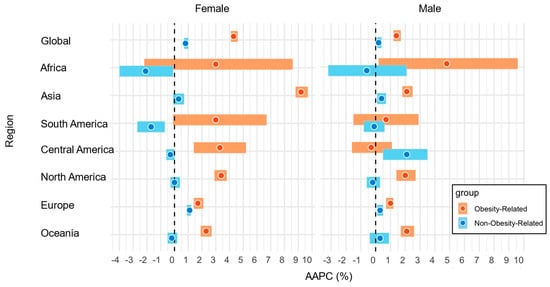
Figure 1
Open AccessArticle
A Clinical–Radiomics Nomogram for the Preoperative Prediction of Aggressive Micropapillary and a Solid Pattern in Lung Adenocarcinoma
by
Xiangyu Xie, Lei Chen, Kun Li, Liang Shi, Lei Zhang and Liang Zheng
Curr. Oncol. 2025, 32(6), 323; https://doi.org/10.3390/curroncol32060323 - 30 May 2025
Abstract
Background: A micropapillary pattern (MP) and solid pattern (SP) in lung adenocarcinoma (LUAD), a major subtype of non-small-cell lung cancer (NSCLC), are associated with a poor prognosis and necessitate accurate preoperative identification. This study aimed to develop and validate a predictive model combining
[...] Read more.
Background: A micropapillary pattern (MP) and solid pattern (SP) in lung adenocarcinoma (LUAD), a major subtype of non-small-cell lung cancer (NSCLC), are associated with a poor prognosis and necessitate accurate preoperative identification. This study aimed to develop and validate a predictive model combining clinical and radiomics features for differentiating a high-risk MP/SP in LUAD. Methods: This retrospective study analyzed 180 surgically confirmed NSCLC patients (Stages I–IIIA), randomly divided into training (70%, n = 126) and validation (30%, n = 54) cohorts. Three prediction models were constructed: (1) a clinical model based on independent clinical and CT morphological features (e.g., nodule size, lobulation, spiculation, pleural indentation, and vascular abnormalities), (2) a radiomics model utilizing LASSO-selected features extracted using 3D Slicer, and (3) a comprehensive model integrating both clinical and radiomics data. Results: The clinical model yielded AUCs of 0.7975 (training) and 0.8462 (validation). The radiomics model showed superior performance with AUCs of 0.8896 and 0.8901, respectively. The comprehensive model achieved the highest diagnostic accuracy, with training and validation AUCs of 0.9186 and 0.9396, respectively (DeLong test, p < 0.05). Decision curve analysis demonstrated the enhanced clinical utility of the combined approach. Conclusions: Integrating clinical and radiomics features significantly improves the preoperative identification of aggressive NSCLC patterns. The comprehensive model offers a promising tool for guiding surgical and adjuvant therapy decisions.
Full article
(This article belongs to the Special Issue Artificial Intelligence in Thoracic Surgery)
►▼
Show Figures

Figure 1
Open AccessSystematic Review
CAR-T Cell Therapy for Acute Myeloid Leukemia: Where Do We Stand Now?
by
Pilar Lloret-Madrid, Pedro Chorão, Manuel Guerreiro and Pau Montesinos
Curr. Oncol. 2025, 32(6), 322; https://doi.org/10.3390/curroncol32060322 - 30 May 2025
Abstract
Background: Patients with refractory and relapsed acute myeloid leukemia (R/R AML) face a dismal prognosis. CAR-T therapy has emerged as a potential treatment option. This study assesses the available clinical evidence on CAR-T in R/R AML, focusing on safety and efficacy outcomes.
[...] Read more.
Background: Patients with refractory and relapsed acute myeloid leukemia (R/R AML) face a dismal prognosis. CAR-T therapy has emerged as a potential treatment option. This study assesses the available clinical evidence on CAR-T in R/R AML, focusing on safety and efficacy outcomes. Methods: We included studies on CAR-T therapy for R/R AML published from June 2014 to January 2025. Data on patient and disease characteristics, CAR-T constructs, response rates, post-CAR-T allogeneic HSCT (allo-HSCT), and safety outcomes were analyzed. Results: Twenty-five CAR-T clinical trials involving 296 patients were identified. The most frequently targeted antigens were CD33, CD123, and CLL-1, while CD7, CD19, NKG2D, and CD38 were also explored. Responses were heterogeneous and often short-lived when not consolidated with allo-HSCT. Cytokine release syndrome and neurotoxicity were generally low grade and manageable. Prolonged and severe myelosuppression was a frequent limiting toxicity, often requiring allo-HSCT to restore hematopoiesis. Disease progression was the leading cause of death, followed by infections. Conclusions: CAR-T cell therapy may represent a feasible therapeutic strategy, particularly as bridging to allo-HSCT to mitigate myelotoxicity and improve long-term outcomes. Nevertheless, it remains in the early stages of development and faces significant efficacy and safety challenges that must be addressed in future trials to enable the expansion of this promising therapeutic approach for a population with high unmet medical needs.
Full article
(This article belongs to the Special Issue Future Perspectives for Treatment and Diagnosis of Acute Myeloid Leukemia (AML))
►▼
Show Figures
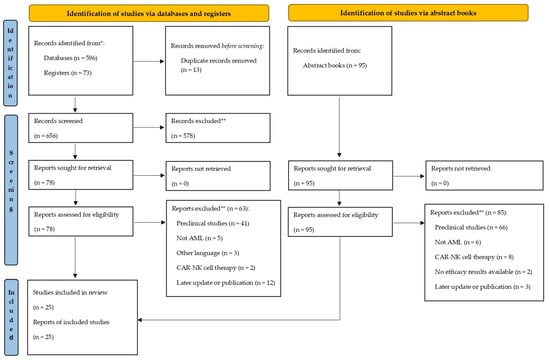
Figure 1
Open AccessArticle
Can Deep Learning-Based Auto-Contouring Software Achieve Accurate Pelvic Volume Delineation in Volumetric Image-Guided Radiotherapy for Prostate Cancer? A Preliminary Multicentric Analysis
by
Cristiano Grossi, Fernando Munoz, Ilaria Bonavero, Eulalie Joelle Tondji Ngassam, Elisabetta Garibaldi, Claudia Airaldi, Elena Celia, Daniela Nassisi, Andrea Brignoli, Elisabetta Trino, Lavinia Bianco, Silvia Leardi, Diego Bongiovanni, Chiara Valero and Maria Grazia Ruo Redda
Curr. Oncol. 2025, 32(6), 321; https://doi.org/10.3390/curroncol32060321 - 30 May 2025
Abstract
Background: Radiotherapy (RT) is a mainstay treatment for prostate cancer (PC). Accurate delineation of organs at risk (OARs) is crucial for optimizing the therapeutic window by minimizing side effects. Manual segmentation is time-consuming and prone to inter-operator variability. This study investigates the performance
[...] Read more.
Background: Radiotherapy (RT) is a mainstay treatment for prostate cancer (PC). Accurate delineation of organs at risk (OARs) is crucial for optimizing the therapeutic window by minimizing side effects. Manual segmentation is time-consuming and prone to inter-operator variability. This study investigates the performance of Limbus® Contour® (LC), a deep learning-based auto-contouring software, in delineating pelvic structures in PC patients. Methods: We evaluated LC’s performance on key structures (bowel bag, bladder, rectum, sigmoid colon, and pelvic lymph nodes) in 52 patients. We compared auto-contoured structures with those manually delineated by radiation oncologists using different metrics. Results: LC achieved good agreement for the bladder (median Dice: 0.95) and rectum (median Dice: 0.83). However, limitations were observed for the bowel bag (median Dice: 0.64) and sigmoid colon (median Dice: 0.6), with inclusion of irrelevant structures. While the median Dice for pelvic lymph nodes was acceptable (0.73), the software lacked sub-regional differentiation, limiting its applicability in certain other oncologic settings. Conclusions: LC shows promise for automating OAR delineation in prostate radiotherapy, particularly for the bladder and rectum. Improvements are needed for bowel bag, sigmoid colon, and lymph node sub-regionalization. Further validation with a broader and larger patient cohort is recommended to assess generalizability.
Full article
(This article belongs to the Special Issue Evolution of Treatments of Prostate Cancer: From Biology to Current Advanced Technologies)
►▼
Show Figures
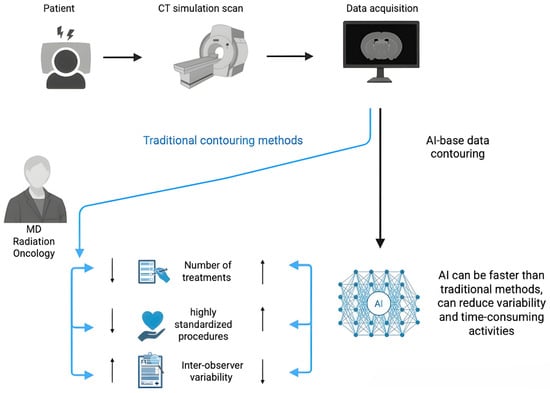
Figure 1
Open AccessArticle
Evaluating Management of Extra-Abdominal Desmoid Fibromatosis: A Retrospective Analysis of Treatments, Outcomes and Recurrence Patterns
by
Vidhi Saraf, Hariharan Triplicane Dwarakanathan, Al-Muaayad Al-Abri, Ioanna Nixon, Sarah Vaughan, Ashish Mahendra and Sanjay Gupta
Curr. Oncol. 2025, 32(6), 320; https://doi.org/10.3390/curroncol32060320 - 30 May 2025
Abstract
Background: Desmoid fibromatosis (DF) is a rare, locally aggressive soft tissue tumour with unpredictable clinical behaviour. Historically, treatment has involved surgery; however, contemporary guidelines, such as those from the Desmoid Tumour Working Group, advocate active surveillance. This article reviews current perspectives on DF,
[...] Read more.
Background: Desmoid fibromatosis (DF) is a rare, locally aggressive soft tissue tumour with unpredictable clinical behaviour. Historically, treatment has involved surgery; however, contemporary guidelines, such as those from the Desmoid Tumour Working Group, advocate active surveillance. This article reviews current perspectives on DF, focusing on epidemiology, pathogenesis, treatment strategies, emerging research directions and cost effectiveness based on our experience at the West of Scotland Musculoskeletal Oncology Service, Glasgow Royal Infirmary (GRI). Methodology: We reviewed 101 patients diagnosed with desmoid fibromatosis between 2010 and 2024. A review of patient records was conducted to gather information on demographics, date of diagnosis, prior treatment, treatment initiation, intervention types, imaging intervals, follow-up duration, recurrence rate for surgery and other intervention, and discharge timelines. All data was systematically organized and analyzed to assess our outcomes. Results: Out of 101 patients with DF in the study, 66% were females. The most common site of primary tumour was lower extremity (39.6%) followed by near equal distribution in upper extremity and trunk. Out of the total cases, 72 (71.2%) were successfully managed with active surveillance involving serial imaging and clinical reviews in accordance with European guidelines. A total of 22 patients (21%) received treatment: 10 underwent surgery alone, 2 had surgery combined with radiotherapy, 8 received only radiotherapy, 1 was treated with hormonal therapy and 1 participated in a trial with Nirogacestat. Of the seven remaining patients, six had unplanned surgery outside followed by active surveillance at GRI. One patient was on alternative treatment modality, homeopathy. The average number of MRI scans per patient was 3.11, with many patients requiring significantly more imaging. MRI surveillance varies significantly in desmoid tumours due to their heterogeneous behaviour. Active or symptomatic tumours often require more frequent scans (every 3–6 months), while stable cases may need only imaging annually or just clinical monitoring. Recurrence was noted in eight patients, all of which were related to prior surgery. The total combined cost of imaging and appointments exceeds £6500 per patient in active surveillance. Conclusions: We conclude that most patients with desmoid fibromatosis in our cohort were effectively treated with active surveillance, consistent with current European guidelines. Surgical management of desmoid fibromatosis in our cohort is historic and has shown a significant recurrence risk. Our study proposes a revised follow-up protocol that significantly reduces costs without compromising on patient care. We suggest a two-year surveillance period for stable disease with patient-initiated return to reduce unnecessary clinic visits, imaging and healthcare costs.
Full article
(This article belongs to the Special Issue An In-Depth Review of Desmoid Tumours)
►▼
Show Figures
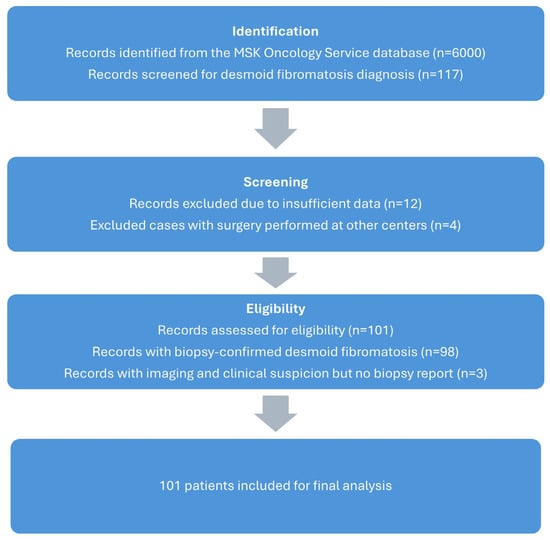
Figure 1
Open AccessReview
Allogeneic Stem Cell Transplantation: The Relevance of Conditioning Regime Intensity for Myelodysplastic Syndromes (MDS)
by
Tobias Berg, Brittany Salter, Michael Radford, He Tian Tony Chen and Brian Leber
Curr. Oncol. 2025, 32(6), 319; https://doi.org/10.3390/curroncol32060319 - 30 May 2025
Abstract
Allogeneic hematopoietic cell transplantation (alloHCT) is the sole curative therapy for myelodysplastic syndrome (MDS). While alloHCT clearly confers a significant survival advantage in high-risk MDS, it is less clear how the disease burden and impact of conditioning intensity impact survival. This review addresses
[...] Read more.
Allogeneic hematopoietic cell transplantation (alloHCT) is the sole curative therapy for myelodysplastic syndrome (MDS). While alloHCT clearly confers a significant survival advantage in high-risk MDS, it is less clear how the disease burden and impact of conditioning intensity impact survival. This review addresses critical issues surrounding this topic, emphasizing the unique cell biology of MDS and the evolving concepts of conditioning intensity compared to other diseases, including acute myeloid leukemia (AML). The review is structured around three interconnected themes. First, it clarifies the varying interpretations of conditioning intensity. Second, it examines the interplay between disease burden at transplant and conditioning intensity in determining outcomes, including a comparative analysis with acute myeloid leukemia (AML) to highlight similarities and differences. Third, it explores the relationship between conditioning regimen intensity and immune reconstitution, particularly focusing on the graft-versus-tumor (GvT) effect and its potential modulation by conditioning intensity. Understanding the stem cell target of conditioning regimens is emphasized, as the persistence of the underlying MDS stem cell necessitates a thorough understanding of this concept for improved therapeutic strategies.
Full article
(This article belongs to the Special Issue Allogeneic Stem Cell Transplantation: Does the Conditioning Regimen Intensity Still Matter?)
►▼
Show Figures
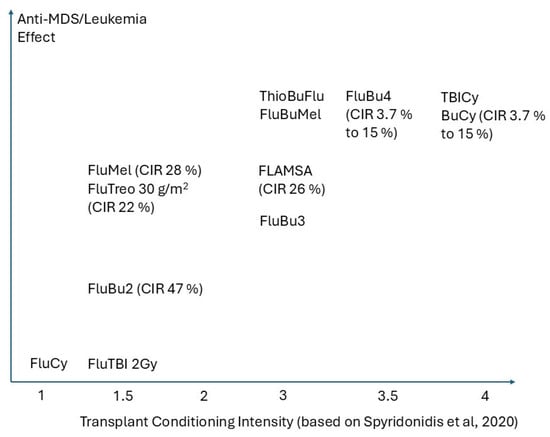
Figure 1
Open AccessArticle
The Design of a Patient-Centered Hierarchal Composite Outcome for a Multi-Center Randomized Controlled Trial in Metastatic Bone Disease
by
Hadia Farrukh, Abbey Kunzli, Olivia Virag, Nathan O’Hara, Sheila Sprague, Amy Cizik, Ricardo Gehrke-Becker, Thomas Schubert and Michelle Ghert
Curr. Oncol. 2025, 32(6), 318; https://doi.org/10.3390/curroncol32060318 - 30 May 2025
Abstract
The proximal femur represents the most frequent site in the appendicular skeleton for metastatic bone disease (MBD) to occur, with a high risk for pathologic fracture. While surgical stabilization is typically used to manage fractures, reconstruction approaches are gaining popularity due to improved
[...] Read more.
The proximal femur represents the most frequent site in the appendicular skeleton for metastatic bone disease (MBD) to occur, with a high risk for pathologic fracture. While surgical stabilization is typically used to manage fractures, reconstruction approaches are gaining popularity due to improved survival. Previous studies have focused on clinical outcomes, but patient-centered outcomes remain underexplored. This study aims to develop a patient-centered primary outcome for the Proximal FEmur Reconstruction or Internal Fixation fOR Metastases (PERFORM) Randomized Controlled Trial, employing a mixed-methods approach. First, a focus group with advanced cancer patients and caregivers identified relevant outcomes. Next, a discrete choice experiment (DCE) assessed the importance of these outcomes among stakeholders, including surgeons, patients and caregivers. The most important components for the primary outcome were identified: mortality within twelve months, physical function assessed at four months using the PROMIS® Global Physical Function score, and the number of days at home within twelve months. The DCE further confirmed that survival and physical function were most prioritized. The PERFORM trial’s primary outcome, developed through extensive stakeholder engagement, will guide the evaluation of surgical approaches for MBD of the proximal femur and has the potential to influence patient-centered practice.
Full article
(This article belongs to the Section Bone and Soft Tissue Oncology)
►▼
Show Figures
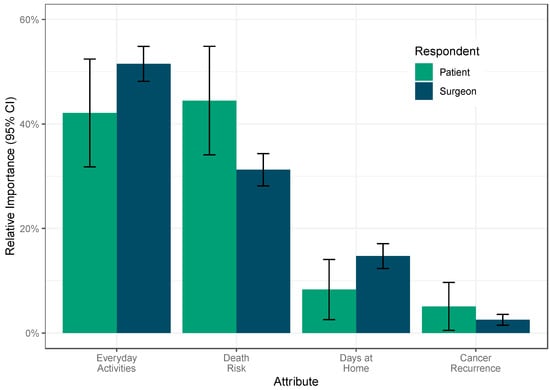
Figure 1

Journal Menu
► ▼ Journal Menu-
- Current Oncology Home
- Aims & Scope
- Editorial Board
- Reviewer Board
- Topical Advisory Panel
- Instructions for Authors
- Special Issues
- Topics
- Sections & Collections
- Article Processing Charge
- Indexing & Archiving
- Editor’s Choice Articles
- Most Cited & Viewed
- Journal Statistics
- Journal History
- Journal Awards
- Society Collaborations
- Conferences
- Editorial Office
Journal Browser
► ▼ Journal Browser-
arrow_forward_ios
Forthcoming issue
arrow_forward_ios Current issue - Volumes not published by MDPI
Highly Accessed Articles
Latest Books
E-Mail Alert
News
Topics
Topic in
Biomedicines, Current Oncology, Diagnostics, Gastrointestinal Disorders, JCM, Livers, Transplantology
Advances in Gastrointestinal and Liver Disease: From Physiological Mechanisms to Clinical Practice
Topic Editors: Davide Giuseppe Ribaldone, Gian Paolo CavigliaDeadline: 20 June 2025
Topic in
Biomolecules, CIMB, Sci. Pharm., Cancers, Current Oncology, Cells
The Role of Extracellular Vesicles as Modulators of the Tumor Microenvironment
Topic Editors: Nils Ludwig, Miroslaw J SzczepanskiDeadline: 30 June 2025
Topic in
Cancers, Diagnostics, JCM, Current Oncology, Gastrointestinal Disorders, Biomedicines, Therapeutics
Hepatobiliary and Pancreatic Diseases: Novel Strategies of Diagnosis and Treatments
Topic Editors: Alessandro Coppola, Damiano Caputo, Roberta Angelico, Domenech Asbun, Chiara MazzarelliDeadline: 20 August 2025
Topic in
Cancers, Current Oncology, JCM, Medicina, Onco
Cancer Biology and Radiation Therapy: 2nd Edition
Topic Editors: Chang Ming Charlie Ma, Ka Yu Tse, Ming-Yii Huang, Mukund SeshadriDeadline: 16 October 2025

Conferences
Special Issues
Special Issue in
Current Oncology
Recent Advances in Transplant Oncology
Guest Editors: Boris Luis Gala-López, Blaire AndersonDeadline: 10 June 2025
Special Issue in
Current Oncology
Advances in B-cell Lymphoma: From Diagnostics to Cure
Guest Editors: Leo Gordon, Megan E. MelodyDeadline: 15 June 2025
Special Issue in
Current Oncology
Artificial Intelligence in Thoracic Surgery
Guest Editor: Marc BoadaDeadline: 15 June 2025
Special Issue in
Current Oncology
Immunotherapy in Thoracic Malignancies
Guest Editors: Cheryl Ho, Randeep SanghaDeadline: 15 June 2025
Topical Collections
Topical Collection in
Current Oncology
New Insights into Prostate Cancer Diagnosis and Treatment
Collection Editor: Sazan Rasul
Topical Collection in
Current Oncology
New Insights into Breast Cancer Diagnosis and Treatment
Collection Editors: Filippo Pesapane, Matteo Suter
Topical Collection in
Current Oncology
Editorial Board Members’ Collection Series in "Exercise and Cancer Management"
Collection Editors: Linda Denehy, Ravi Mehrotra, Nicole Culos-Reed
Topical Collection in
Current Oncology
Editorial Board Members’ Collection Series: Contemporary Perioperative Concepts in Cancer Surgery
Collection Editors: Vijaya Gottumukkala, Jörg Kleeff









